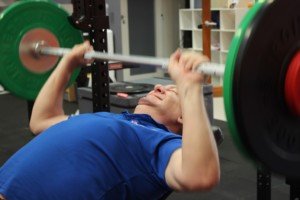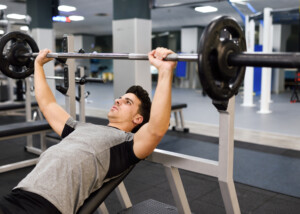
The guidelines for bench pressing with a thoracic aortic aneurysm are not encouraging.
If you found this article, you’ve probably been diagnosed, or know someone who has, with a thoracic aortic aneurysm—and know exactly what this is.
And you probably lift weights or were planning on taking this up, including the bench press.
“Once someone is diagnosed with a thoracic aortic aneurysm, a common question is whether or not they can exercise,” begins Jack Wolfson, DO, FACC, a practicing cardiologist in Arizona, author of The Paleo Cardiologist: The Natural Way to Heart Health.
“The concern, of course, is to avoid an event that could cause the affected blood vessel to rupture.
“There are many reports in the literature and small studies which document heavy exertion as a precipitating factor.”
CAN a person with a thoracic aortic aneurysm bench press in a safe manner?
Well, the motion of bench pressing isn’t the issue. It’s the weight of the barbell.
Lifting weights increases blood pressure during the movement (though weightlifting will lower resting blood pressure as the individual becomes more trained).
A person with a thoracic aortic aneurysm must avoid activities that raise blood pressure, because forceful pressure within the bulging portion of the aorta can cause it to dissect.
Dr. Wolfson says, “Activities to be avoided include anything which involves strenuous lifting. I tell most people that 25 pounds is probably the upper limit.”
This is where it gets tricky. A 50-year-old woman who has never trained with weights should be strong enough to bench press 25 pounds for a number of repetitions.
As a fitness expert, I know for a fact that novice women, even middle aged, can often start out with the 45 pound unloaded Olympic bar for the bench press.
As a former personal trainer, I never started my novice female clients at 25 pounds for the bench press—this is way too light.
You can imagine how light this would be to a man—especially if he’s been working out for a while.
So the restriction of lifting no more than 25 pounds, in someone with a thoracic aortic aneurysm, would seemingly more apply to lifts that recruit only a small amount of muscle and involve a non-efficient body position.
For example, hoisting eight, 25 pound sacks into a truck is more strenuous than bench pressing this same amount of weight for eight repetitions.
Suppose a man, who regularly bench presses 225 for reps, learns he has a thoracic aortic aneurysm (e.g., a chest X-ray for suspected pneumonia reveals it).
Does this mean to drop his bench press down to 25 pounds, even though 100 pounds would be a walk in the park for him?
How about a compromise of 50 pounds, since the bench press motion is done while lying down and recruits many more muscle fibers than, say, lifting a 25 pound kettlebell straight out in front of yourself?
No data this refined exists to answer these questions, but on the other hand, because this data does not exist (and maybe one day it will), such an individual should give up bench pressing altogether to avoid the temptation to return to a more strenuous level.
“Check with your doctor to devise an exercise plan that is appropriate for you,” says Dr. Wolfson.
“Make sure to ask questions about specific activities you may be considering.
“Your doctor may want to perform an exercise stress test to determine your blood pressure response to activity.”

 Wolfson Integrative Cardiology
Wolfson Integrative Cardiology
























